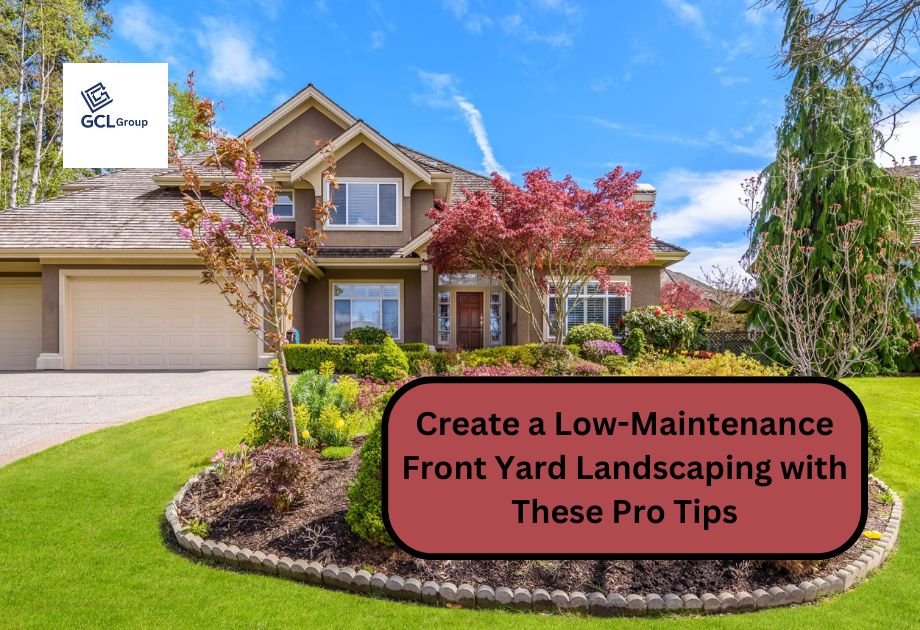Landscaping your front yard can seem like a daunting task, especially if you’re trying to keep maintenance to a minimum. Fortunately, with the right planning, design choices, and plant selection, you can create a beautiful, inviting space that won’t take up all your free time. In this guide, we’ll explore practical tips and ideas to design a low-maintenance front yard that looks great year-round.
1. Start with a Plan
The key to creating a low-maintenance front yard is starting with a solid plan. Take time to assess your space, sunlight exposure, soil conditions, and climate. Knowing these factors will help you choose the right plants and design features. A well-thought-out design minimizes the need for future adjustments, saving time and money.
- Tip: Sketch a layout of your yard and identify areas for hardscaping, planting beds, and open spaces.
2. Focus on Hardscaping
Hardscaping, or using non-living elements like stones, gravel, pavers, and mulch, reduces the amount of plant care required. Consider incorporating paths, patios, or gravel beds to add texture and visual appeal. These features require little to no maintenance and reduce the area you need to mow or water.
- Popular choices: Stone pathways, brick pavers, gravel, and mulch.
3. Choose Low-Maintenance Plants
Select native plants that thrive in your climate and soil type. Native plants are accustomed to local weather patterns, making them more resistant to drought, pests, and diseases. Also, opt for perennials, shrubs, and ground covers that require less care than high-maintenance flowers and grasses.
- Good options: Lavender, ornamental grasses, succulents, and evergreens.
- Tip: Avoid plants that need frequent watering, pruning, or fertilizing.
4. Consider Ground Covers Over Grass
Grass lawns can be high-maintenance, requiring regular mowing, watering, and fertilizing. Instead, consider replacing some or all of your lawn with ground covers like creeping thyme, clover, or sedum. These plants spread quickly, need minimal care, and often require less water than traditional lawns.
- Benefits: No mowing, minimal watering, and a unique look.
- Bonus: Ground covers can be great for suppressing weeds.
5. Use Mulch to Control Weeds
Mulch is one of the best tools for reducing maintenance in your front yard. It helps suppress weeds, retains moisture, and adds a finished look to your planting beds. Organic mulches like bark or compost slowly decompose, enriching the soil and reducing the need for fertilizers.
- Tip: Spread a 2-3 inch layer of mulch around plants and trees, but keep it away from the trunks to avoid rot.
6. Install an Automated Irrigation System
Watering can be a time-consuming chore, but an automated irrigation system can take care of it for you. Drip irrigation systems or sprinklers on timers ensure your plants get the right amount of water without over-watering or under-watering. Plus, these systems are highly efficient and help conserve water.
- Tip: Opt for a drip system that waters plants at their roots, reducing evaporation and water waste.
7. Opt for Evergreen Plants for Year-Round Appeal
Evergreens are a great choice for low-maintenance landscaping because they look beautiful throughout the year. They don’t drop leaves in the fall, which means less raking and cleanup for you. Planting a mix of evergreen shrubs and trees adds structure and greenery to your front yard with little effort.
- Good choices: Boxwood, juniper, and dwarf pine varieties.
8. Incorporate Decorative Containers and Raised Beds
Raised garden beds and container plants are excellent for adding interest to your landscape while keeping maintenance low. They allow you to control soil quality and moisture more effectively. Plus, container plants are easy to replace or rearrange seasonally, offering flexibility in design.
- Tip: Use self-watering containers for an even lower-maintenance solution.
9. Limit the Number of Flowering Plants
Flowering plants add beauty to your yard, but many varieties require regular deadheading, watering, and care. Limit the number of flowering plants in your design, focusing instead on low-maintenance shrubs, grasses, and evergreens. You can still add pops of color with perennials or annuals that are known for being hardy.
- Low-maintenance flowering plants: Coneflower, Black-eyed Susan, and Russian sage.
10. Design for Easy Maintenance
When planning your front yard, think about ease of access for maintenance tasks like weeding, trimming, and mowing. Keep plants spaced apart for airflow and easy cleaning. Group plants with similar water and sunlight needs together to streamline care. These design decisions can save time in the long run.
11. Install a Low-Maintenance Pathway
A well-designed pathway not only adds functionality to your yard but also minimizes lawn space. Gravel or stone pathways require little maintenance and can guide visitors through your landscape, reducing wear on grass areas.
- Tip: Choose durable materials like pea gravel or flagstone for longevity and style.
Conclusion
Creating a low-maintenance front yard landscape is all about smart choices. By incorporating hardscaping elements, using native and drought-tolerant plants, installing automated watering systems, and planning a thoughtful layout, you can achieve a beautiful yard that requires minimal effort to maintain. With these pro tips, you’ll spend less time working in your yard and more time enjoying its beauty.
By following these simple strategies, you can achieve a well-designed, eco-friendly, and low-maintenance front yard that adds curb appeal and value to your home. The key is to focus on durable, low-care plants and materials while creating a landscape that fits your style and schedule.
| Home | Click Here |
| Category | Click Here |

